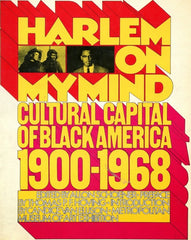
Museums have become better at creating more relevant and diverse exhibits. However, there was a point in time when the majority of museum exhibitions showcased one-sided and quite frankly highly elitist exhibits and narratives. A few exhibits forced museums and museum professionals to face the communities' demands for more relevant, cultivating material. Folks were and are still very tired of glorifying certain narratives, artists, and historical figures.
These exhibits are just a few that created some drama and shed light on the prejudice and inequality that can exist within museums...and I wish I could have experienced them all. Of course, I would love to experience these exhibits first hand, but I really wish I could have contributed to the conversations and observe the moments of realizations. I wish the proposed course of action for change was recorded. It's very interesting to hear discussions about people of color, but lack of person of color to add perspective. Borrowing from the Hamilton Play, I wish I were in the room where it happened. For now, I'll sit on my sofa, sipping tea, smiling devilishly as these exhibits shook the museum world.
I encourage you to share a cup of tea with me and do more research on these exhibits. I can’t give you all the tea in one blog post alone.
Harlem on My Mind
"There were no black curators, no black administrations, no black secretaries, and there were certainly no black trustees. It was totally an upstairs, downstairs situation."
The quote above is borrowed from Mounting Frustration: The Art Museum in The Age of Black Power. I love this book! It gives those first-hand accounts which history buffs like myself love. The book provides perspectives from every angle, allowing you to shake your head at the amount of seclusion that existed and still exist within museums. Anyway, this is not a book review, but I highly recommend it!

Harlem on My Mind was an exhibit I really wish I could have experienced in person. After reading the history and mission of the exhibit, I feel I would have walked away, feeling confused and angry. The show opened at The Metropolitan Museum of Art in 1969. Curator, Allon Schoener, aimed to highlight Harlem's history since 1900s, and he intended to do so with floor-to-ceiling photo-murals. The new concept and idea of this exhibit was not a major problem. The fact that this exhibit included many photographs capturing the African-American lifestyle of Harlem, yet excluded any contribution from black artists, sculptors, or photographers is the juicy part. Again, a scene or conversation created with people of color as the core but lacked diverse representations in the discussion. The Black Emergency Cultural Coalition opposed the misrepresentation during the black-tie opening by marching the streets with picket signs...(Sips more tea!)
Harlem on My Mind made it very clear that attempting to tell the history of a specific demographic by excluded that demographic is the behavior of an uncultured institution.

Mining the Museum

Ahhh Mining the Museum, hosted at The Maryland Historical Society(MdHS), in Baltimore, Maryland, 1992. MdHS is actually my old stomping grounds. If I had a dollar every time I was asked, "do you know about Mining the Museum?" from visitors while working at the front desk in 2017, I would be a thousand-aire by now. Not a millionaire. Surprisingly, when I bring this exhibit up in conversation to non-Maryland residents, I get confused looks. More seasoned museum professionals know about it, but younger museum-goers do not.
I received a variety of responses when asked about the exhibit. Some folks felt as I; they wish they could have experienced it’s gloriousness first-hands. Others were pleased that it was gone. Quoting one gentleman in particular, "it was a disgrace, and museums should stick to telling history." Well, this exhibit did stick to telling history. It showcased the not so pretty side of history. It focused on institutionalized racism with a non-traditional point of view.

Mining the Museum was installed by African American Artist, Fred Wilson. Wilson's mission was to investigate and interpret the Collections of MdHS. This exhibit made a lasting impression. Twenty-five years later, folks were still asking and wanting to engage in conversation about it. I found out about this exhibit in grad school and I was sipping my tea then. Honestly, I sip my tea every time this exhibit is mentioned. The most glorious outcome is the display of an early 18th-century portrait of a young white squire named Henry Darnall III; to his right stands a young black man with a metal collar around his neck. The enslaved young man had gone unmentioned by the museum until Wilson's exhibit.
I can recall walking past the painting and immediately searching the panel for acknowledgment. I also remember saying to myself, "it better be there." I have no idea what I would have done if the young black man was not mentioned. But, I do know that I would have felt disappointed. I guess we'll never know for sure. I thank Fred Wilson for his daring exhibit that challenged conservative institutions to think differently.
There are many other exhibits and artworks that created beautiful disturbances for the art world. Mining The Museum and Harlem on My Mind are just my two favorites. If your tea is still warm and you're still thirsty, here are more exhibits that took some museum professionals off their high horses, or took the museum world by surprise. There are plenty more, but you’ll need to fix more tea!
How was this week’s tea?
Walls of exclusion are contentiously being built, but I have the strength of my ancestors to knock them all down. The beautiful thing is, I don't have to do it alone.


Leave a comment